2020.09.17
Overview & Effects of the 2020 Design Law Revision in Japan ( Part 2: Expansion of Related Design System)
Originally Published in Japanese, January 2020; Updated August 2020
Yuki Mori, Japanese Patent Attorney
Expansion of Related Design System
Since the related design system is related to applications in all product fields, it has a particularly large impact on design practice.
The revised system may benefit applicants, but the rules are more complicated than the previous system. There is a possibility that applicants may become trapped in unexpected situations (pitfalls) without proper guidance.
In order to effectively utilize the new system, it is essential to correctly understand the new rules, which are mostly stated in the examination standards.
(1) Main points of revision
One of the highlights of the revision of Design Law is the expansion of the related design system.
The main revisions are the following three points.
Revision point 1: Possibility of registering “a design that is similar only to the related design”
Revision point 2: Extension of application period of related designs
Revision point 3: Partial exemption of novelty requirement, non-creativity requirement, and prior application rule, etc.
(2-1) Revision point 1:
Possibility of registering “a design that is similar only to the related design”
In the previous related design system, the registration requirement was that the related design be “similar only to the main design.” The design “similar to only another related design” could not be registered.
For this reason, as shown in the following passenger car case (see Fig. 8), after the initial design was introduced to the market, the design gradually changed and eventually became different from the initial design. However, even if there is a certain commonality among the successor designs, there was a situation in which all of them could not be registered as one related design group.
▼ Fig. 8
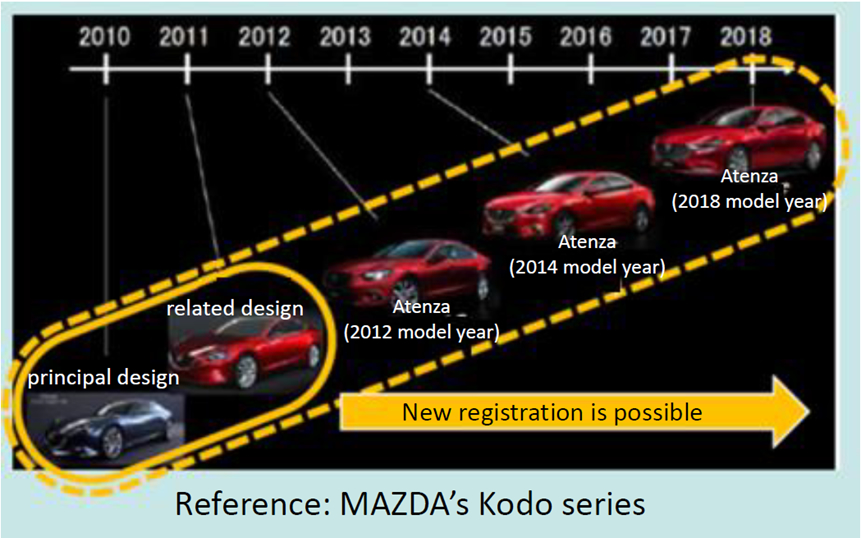
On the other hand, after the revision, “designs similar only to related designs” can be registered in a chain with the related design as the main design, so these can be registered as one related design group (See Fig. 9).
▼ Fig. 9
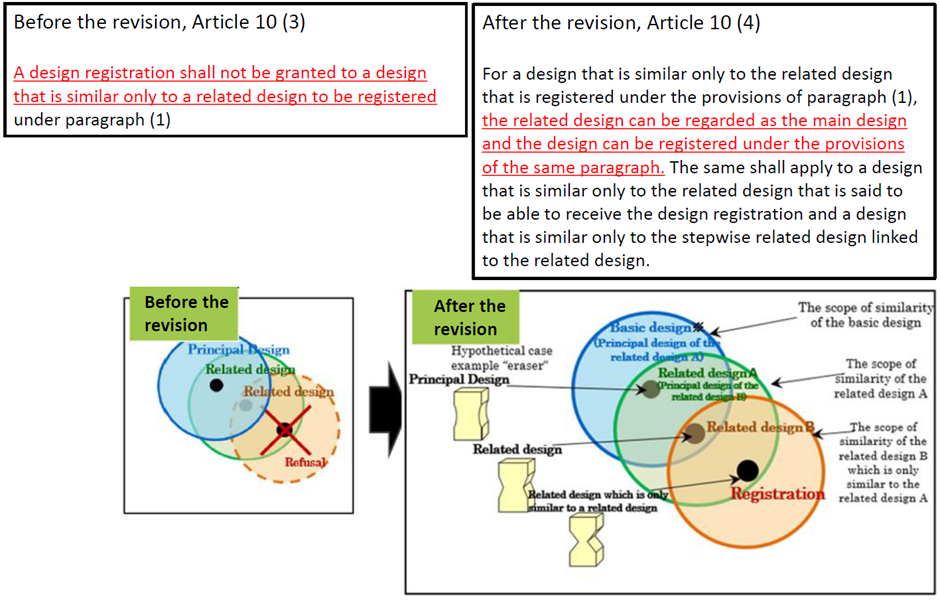
Note that with this revision, the first design selected as the main design is called the “basic design”, and the related design of the basic design and the stepwise related design linked to the related design are referred to as “related to basic design” (see Fig. 10). Both are new terms not found in the previous Design Law.
For example, it seems that the oldest member of the family (founder) may be considered the “basic design” and all subsequent generations of children, grandchildren, and great-grandchildren may be considered “related designs related to the basic design.”
This revision also includes the extension of the term of design right from “20 years from the registration date” to “25 years from the filing date”.
The term of validity (end of rights) of the “related design relating to the basic design” is 25 years from the filing date of the basic design.
Similar to the example above, when the lifetime of the “oldest” expires, so will all descendants.
▼ Fig. 10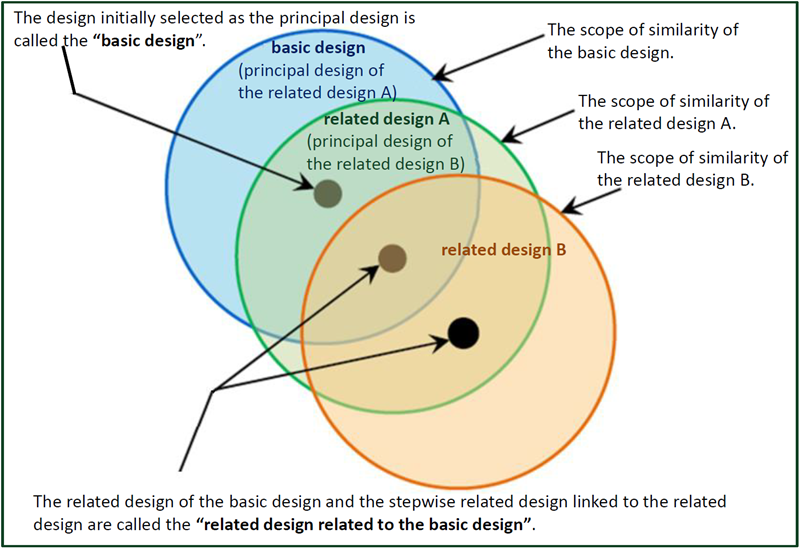
(2-2) Revision point 2: Extension of application period for related designs
In the previous related design system, it was necessary to file an application for a related design “after the filing date of the principal, but only until the day before the issuance date of the design gazette.” It is noted here that the principal design is defined as the design application from which a related design is immediately related from, which may or may not be the basic design. This period was 8 months on average, and compared to the span of design development, the period was often not sufficiently long enough.
In order to improve this, this revision will allow the related designs to be applied for up to “10 years before the basic design filing date” (see Fig. 11).
▼ Fig. 11
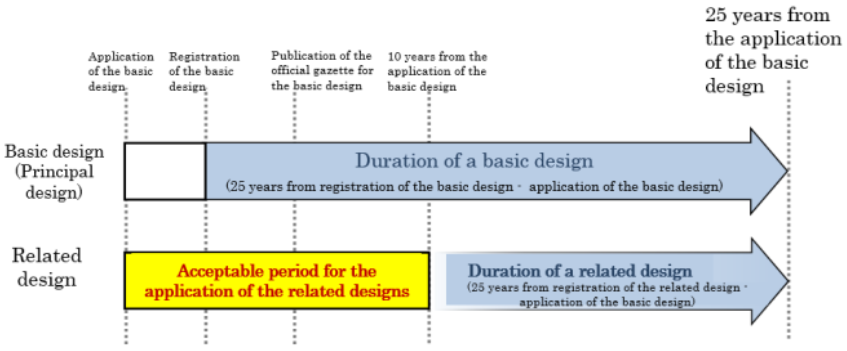
1) Applicability of related designs after the lapse of basic designs
Further, as shown in Fig. 12, even after the “basic design” has lapsed, if the “related design A” still exists, it is possible to register the “related design B” with A as the principal design. (However, other registration requirements must also be met).
On the other hand, even if the “related design C” is applied for using the design B as the principal design while the “related design B” is still in existence, the “C” will not be registered if the “B” has lapsed at the time of the allowance of the “C”.
Determining related designs after the principal design has lapsed can become quite complicated, but it remains an important point.
▼ Fig. 12
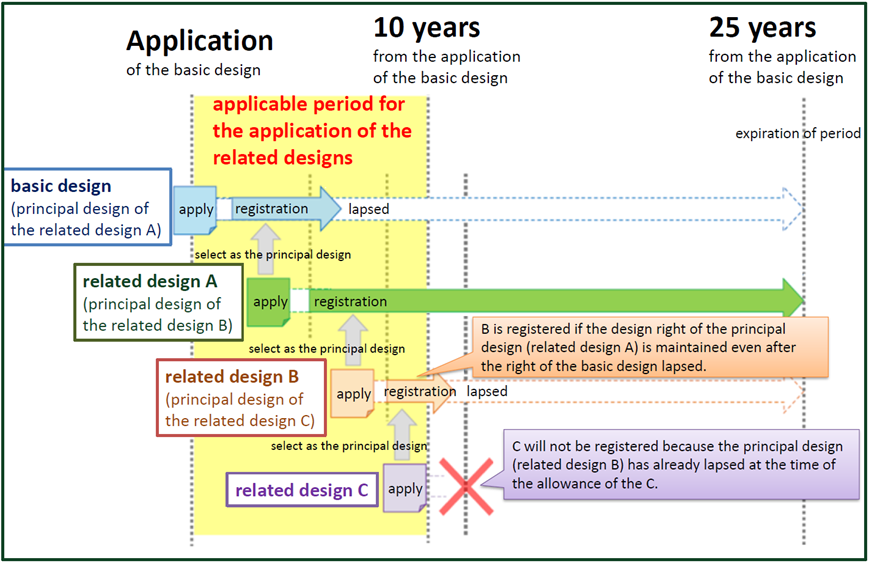
2) The selection of principal design
If the related design being applied for is similar to multiple designs (basic design and other related designs) that belong to a series of related design groups (called a “family” in this article), you can select any of them as the principal design. (Other registration requirements must be met).
In addition, as a result of the examination of the related design application conducted by the JPO, an application could be determined to be “not similar to the principal design described in the application”, however it could be determined to be “similar to other designs in the family.” It is expected that the examiner to specify the design (or if there are multiple designs, all of the designs) in the Reason for Refusal (Article 10(1)).
By showing the examiner’s judgment, the applicant can more easily deal with an amendment to overcome the Refusal, but the result of the similarity judgment with other designs in the family will remain in the file wrapper and be known to a third party, creating negative prosecution history.
In light of these changes in operation at the JPO, it is necessary to exercise caution when selecting the principal design.
(2-3) Revision point 3: Partial exemption of novelty requirement, non-creativity requirement, and prior application rule, etc.
1) Provision to exclude “self-(known) design” from references for refusal
Even if the period for filing related designs is extended to 10 years from the filing date of the basic design, it is highly possible that the same or similar design as the basic design will become publicly known due to the publication of the design gazette of the basic design or public disclosure of the products, etc.
In order to prevent the registration of related designs from being rejected by using such a “self-known design” as a reference, both of the following conditions are set forth to be excluded from the basis of the judgment of novelty, non-creativity, etc. (Article 10, paragraphs 2 and 8).
-
- Applicant’s own publicly known design (called “self-design”), and
- A design that is the same as or similar to the “basic design” or “related design relating to the basic design” that the applicant applied for or registered.
However, this provision allows exceptionally long-term novelty, etc. to be applied to related design applications, and is unique in the international sense. Thus, the revised law has established a regulation that limits the scope of application so that profits are not overly biased only to the applicant (Article 10, paragraph 8, parenthetical).
Keeping these points in mind, I would like to now discuss under what conditions “self-design” is excluded (or not excluded) from references as a basis for refusal.
2) What is “self-design”?
What is the “self-design” in Article 10, paragraphs 2 and 8 after the revision? According to the design examination guidelines, one of the following is considered to be “self-design”.
-
- A design for which an applicant of the related design has the “design right”, or
- A design for which an applicant of the related design has the “right to receive a design registration”
Of course, a design in which “another person” has a design right or the right to receive a design registration does not become a “self-design”.
Therefore, if the related design filed is the same as or similar to the publicly known design of another person (even if there is another “self-design”), the publicly known design of another person may be used as a basis for the rejection. This is the same as before the revision.
On the other hand, even if the person who publicized the design is someone else, if it falls under any of the above i or ii, it will be treated as a “self-design”. In other words, in order to be a “self-design”, the “creator” must be the applicant himself, and the “publisher” can be another person.
Not only the implemented design but also design in the design gazette, patent/utility model gazettes, foreign gazettes, designs published in catalogs, etc., if they fall under any of the above i or ii, can be considered “self-design”.
3) Timing of disclosure of “self-design”
The provisions of Article 10, paragraphs 2 and 8 after the revision (hereinafter referred to as “special measures for self-design” in this article) will be applied only if a “self-design” is one of the following:
- A design that is the same as or similar to the “basic design” of the “design for which the design is to be registered as a related design”, and that has been publicly known since the time of the application (or priority date) of the “basic design”.
- A design that is the same as or similar to the “related design relating to the basic design” of the “design for which the design is to be registered as a related design”, and that has been publicly known since the time of application of the corresponding related design.
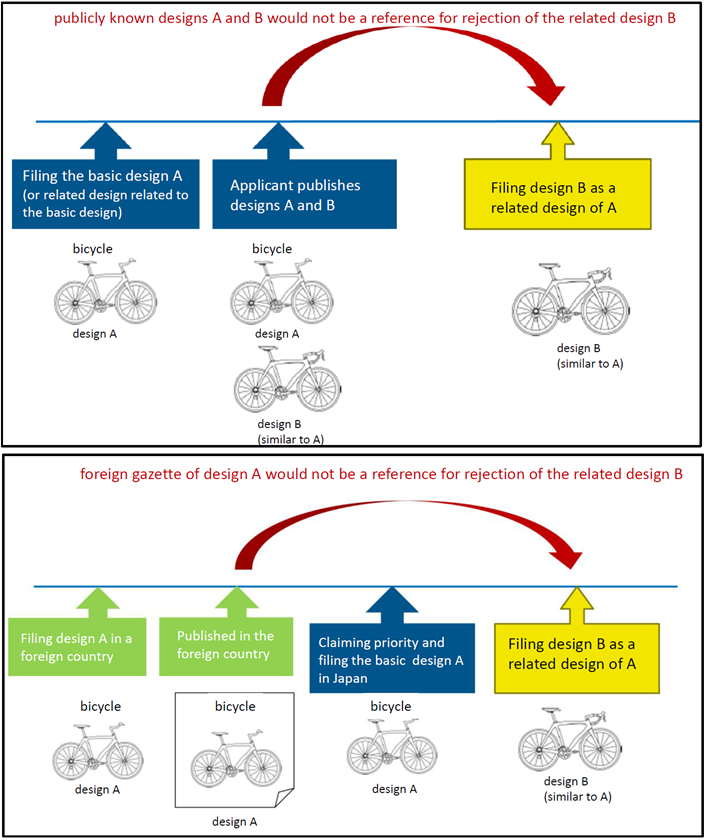
- A design that is the same as or similar to the “basic design” and the “related design related to the basic design” of the “design for which the design is to be registered as a related design”, and an exception of loss of novelty is applied to the “basic design” or “related design related to the basic design.”
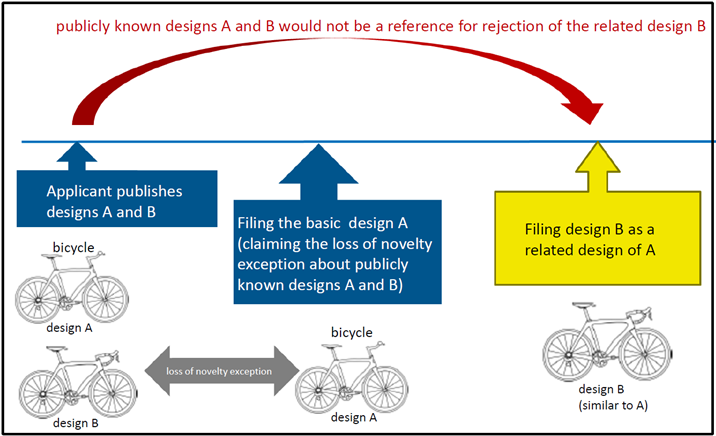
In order to fall under the case iii above, it is necessary for the applicant not only to apply for the loss of novelty exception application, but also for the examination to be actually approved.
For example, suppose that for “Application Design A”, you have submitted a certificate regarding the disclosure facts of “Public Design A” and “Public Design B”, and filed an application for applying the loss of novelty exception. At this time, the applicant recognizes that “Public Design A and B” are similar (or easy to create) to “Application Design A”, but in the examination, regarding “Public Design B”, suppose it is found to be dissimilar (or not easy to create) to “Application Design A”.
In this case, although there is no particular notification from the JPO, the exception of loss of novelty has not been applied to “Public Design B”.
In this state, if “Application Design A” is the principal design and B is applied as a related design, “Public Design B” will be subject to “exception” as a special measure for self-design.
Therefore, it is possible that the “Application Design B” may be rejected by the “Public Design B” unless the exemption of novelty is applied to the “Public Design B” at the time of application of B.
In addition, if the applicant wants to receive the exception of loss of novelty, the “Application Design B” must be filed within one year from the publication date of “Public Design B” (within the period of application of loss of novelty exception). In this case, B is not similar to A and cannot be registered as a related design of A in the first place, so it does not fall under any of the above cases i-iii and cannot receive special measures for self-design.
In this way, the judgment of “whether the public design and the application design are similar or not” and “whether the design applied as a related design and the basic design (other designs in the family) are similar or not” may be different between the applicant and the examiner, there will always be a gray zone as to whether or not they are subject to special measures for self-design.
In the previous practice, it was sufficient to pay attention to “the similarity between the principal design and related designs”, but after the revision, “the similarity between related designs and other designs within the family” and in “the similarity between public design and application design” must also be considered. Thus, an applicant must pay a special attention when considering the similarity of designs.
4) Examples of judgment of “self-design”
In the case where the basic design is a partial design or other creations are added, how is the “self-design” judged? The following examples are shown in the design examination guidelines.
i) When the basic design is a “partial design”
As shown in Fig. 13, when the basic design is a “partial design” and the claimed part (solid line part) of the partial design is the same as or similar to its self-known design, that part is treated as a “self-design.”
The publicly known design 2 is an open car, and its shape is different from the “broken line part” of the basic design. Even in such a case, if the “solid line part” is the same as or similar to the basic design, it can be considered to be a “self-design” (the same can be determined in relation to the “related design related to the basic design”).
▼ Fig. 13
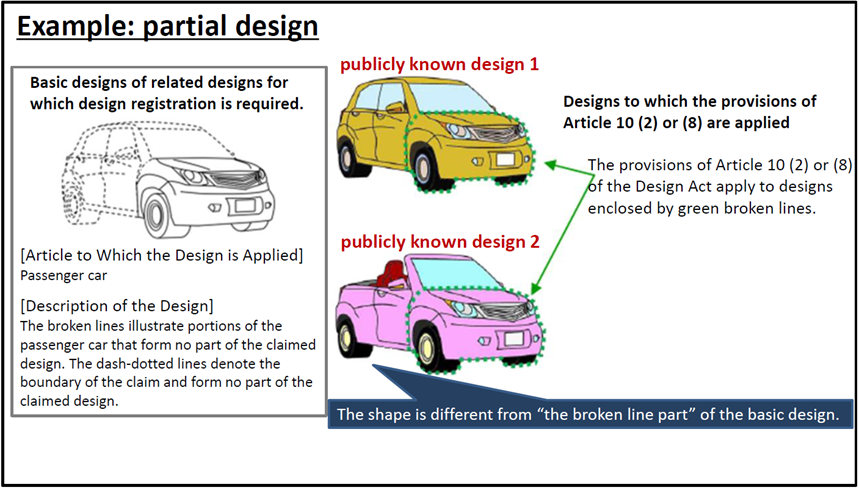
ii) When other creations are added to the “self-design”, Part 1
Even when other creations are added to the “self-design”, the part corresponding to the basic design (or “related design related to the basic design”) is recognized separately from the added creation. Where possible, the original part will be treated as ” self-design”.
For example, as shown in Fig. 14, when the basic design is a design of a part such as a “bicycle saddle” and the publicly known design is a “bicycle” using the saddle, the saddle portion is separated from the bicycle. If it can be recognized as separate, the saddle part can be a “self-design”.
▼ Fig. 14
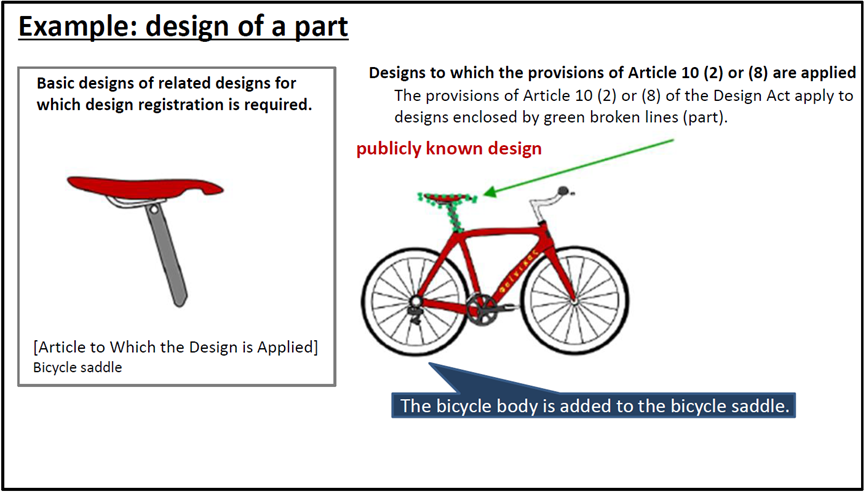
iii) When other creations are added to the “self-design”, Part 2
Even if the basic design is a finished product and another creation is added to it, if the part corresponding to the basic design can be recognized separately from the other added creation, it is treated as “self-design”.
In the example in Fig. 15, the basic design is a completed “passenger car”, while the publicly known design has an air spoiler (another creation) added to the passenger car.
Even in such a case, if the passenger car part can be recognized separately from the air spoiler, the passenger car part can be “self-design”.
The same judgment will be applied whether the air spoiler is added by the applicant or added by another person.
▼ Fig. 15
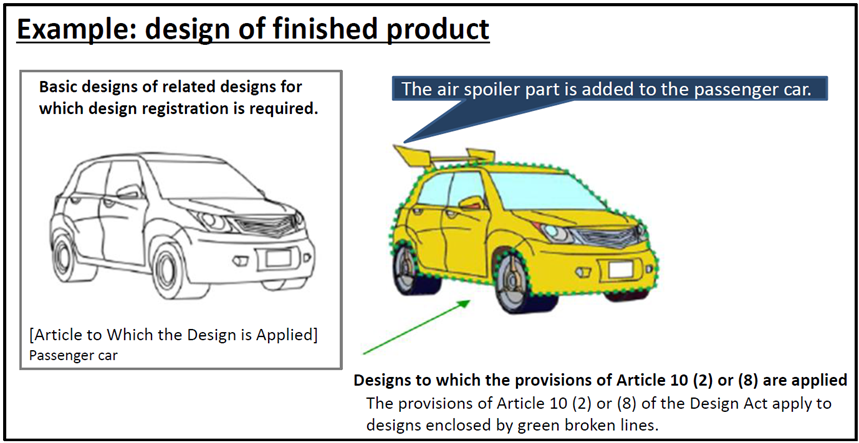
5) Be careful about exemptions (Article 10 paragraph 8, parenthetical)
Finally, I would like to discuss the cases where the special measures for “self-design” do not apply.
After the revision, Article 10, paragraph 8, parenthetical, stipulates the exemption of special measures for “self-design.” After lapse of an application or design right of “basic design” or “related design relating to basic design” are not entitled to the special measures for self-design for “publicly known designs that are the same as or similar to the lapsed design” (see Fig. 16).
If a related design that is the same as or similar to the “self-known design” falls under any of (1) to (7) in Fig. 16, the “self-known design” can become a reference for refusal in the examination of (other) related designs filed later on.
▼ Fig. 16
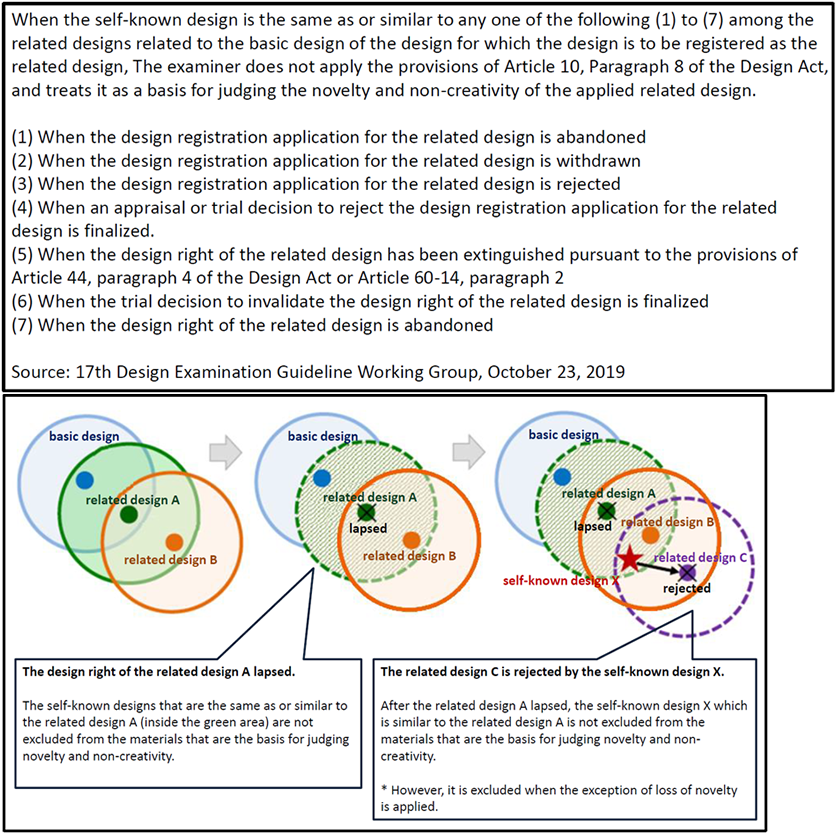
The purpose of such an exemption is that it is disadvantageous to a third party that the design right or application that has lapsed and became entered into the public domain is unexpectedly restored by registering the related design of the later application.
There are many opportunities for applicants/design right owners to accept the reasons for refusal, withdraw the application, or abandon the design right during the lifetime of the design.
In the past, I think it was almost unnecessary to consider the effect on the registrability of other related design applications in such situations, but after the revision, if there is a possibility that a related design will be applied for later, it is necessary to take care not to inadvertently abandon the designs belonging to the family for 10 years from the filing date of the basic design.
i) What is the “related design” in Article 10-8, parenthetical, after the revision?
That is, what does the “related design” in Fig. 16 correspond to? According to the design examination guidelines, when both of the following two requirements are met, the item falls under the category of “related design” in Article 10, paragraph 8, parenthetical.
Requirement 1) “Basic design” or “related design relating to basic design” (that is, a design belonging to a family) is described as the principal design in the application, and
Requirement 2) The judgment that the design of the application is a related design of the “basic design” or “related design related to the basic design” has been notified in the examination, trial or retrial.
Requirement 1) is “Indication of intention by applicant”, and Requirement 2) is “Judgment by JPO”.
Only when these two are met, will the application be exempted, and after the “related design” is lapsed, the special measures for “self-design” cannot be applied to the same or similar self-known design.
ii) What happens when the design right of the basic design has lapsed?
As shown in Fig. 16, Article 10 paragraph 8, parenthetical, is applied when the “related design” has lapsed.
Then, even if the “basic design” has lapsed, is it possible to receive the special measures for “self-design”?
Although this point is not clearly defined in the text, the design examination guidelines state that even if the “basic design” has lapsed, special measures for “self-design” are not allowed.
This is because, in consideration of the purpose of the Article 10 paragraph 8, parenthetical (preventing the restoration of designs in the public domain), it should be interpreted as such.
For example, in the case of Fig. 17, the “related design B” can be registered as related to the “related design A” as the principal design as long as there is no public design that is the same as or similar to the “related design B” even after the lapse of the “basic design.”
However, if there is a “self-known design” that is the same as or similar to the “basic design” before the application of “related design B”, and the “basic design” has lapsed at the time of allowance of B, special measures for “self-design” are not applicable. B is not able to be registered even if the principal design is A (see Note 2 in Fig. 17).
▼ Fig. 17
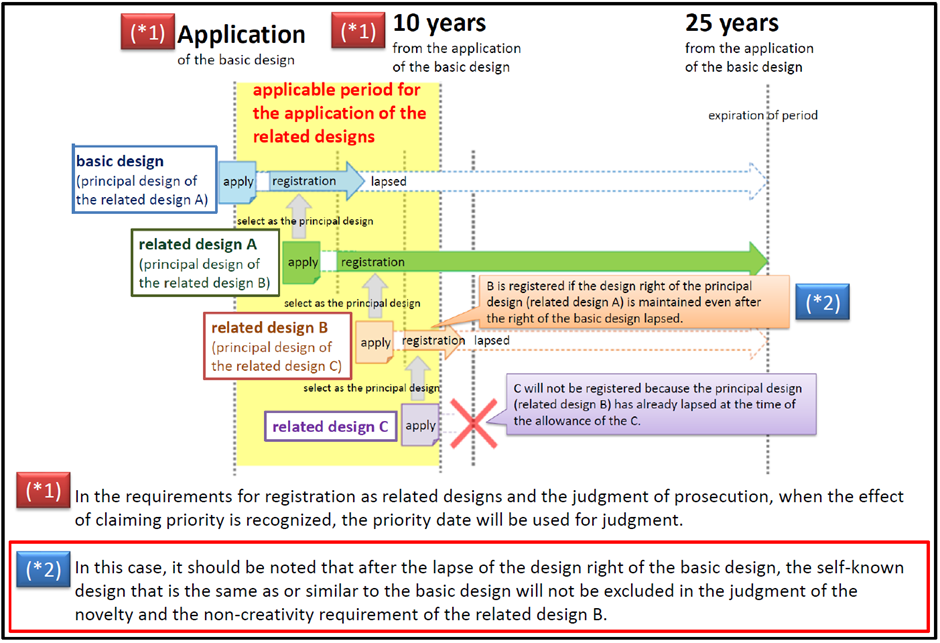
In the revised design practice, after registering the initial design as the “basic design” and then repeating the design changes, if the succeeding design gradually departed from the “basic design”, the design may be registered as the “related design of related”. If the “basic design” is no longer being implemented, I think there are occasions where an abandonment of design rights should be considered.
In that case, before abandoning the design right of the “basic design”, the following must be considered:
– Is there a “self-known design” that is the same as or similar to the “basic design”?
– Is there a possibility of applying for an additional related design in the family?
iii) Summary of “self-design”
As described above, “special measures for self-design” are “exceptional” provisions in the Design Law, which is a creative law. For this reason, exemptions (“Exceptions of exceptions”) are provided to prevent disadvantages to third parties (see Fig. 18).
▼ Fig. 18 Determining novelty and non-creativity in related design applications
| Handling in examination of related design applications | Related articles | |
|---|---|---|
| (1) Principle | Novelty and non-ease of creation are required in relation to “other person’s known designs” and “self-known designs that are not the same as or similar to the basic designs” | Article 3 Paragraph 1 Article 3 Paragraph 2 |
| (2) Exception | “Special measures for self-design” are allowed for self-known designs that are the same as or similar to “basic design” or “related designs related to basic design” | Article 10, paragraphs 2, and 8 |
| (3) Exception of exception | After the “basic design” or “related design related to the basic design” has lapsed, “special measures for self-design” will not be granted for the self-known design of the same or similar to the lapsed design. | Article 10 paragraph 8, parenthetical |
As stated in (1) above, special measures are not allowed after the revision in relation to “publicly known designs relating to the creation of others”.
Despite the 10-year application period for related designs, it is highly likely that counterfeit products and follow-up products will occur early after the launch of products that have a strong customer attraction.
Except for exact copy, in principle, counterfeit products cannot be subject to special measures for self-design and may be rejected for novelty, etc. It is also important not to delay the application period.
iv) Is it possible to file a related design application after the revision based on the principal design registered under the previous law?
Yes, it is possible to file a related design application after the revision based on the principal design registered under the previous law.
It is possible to register “designs similar to designs for which design gazettes have already been issued”, “designs that have been published for more than one year”, and “designs similar to only related designs” as related designs as long as it meets other requirements.
Furthermore, if a design filed “before revision” is designated as the principal design and a related design is filed for and registered as “after revision”, the term of the related design will be “25 years from the filing date of the principal design”. Since the term of the principal design right “before revision” is “20 years from the registration date of the principal design”, there is a possibility that related designs may have longer lifetimes than the principal design.
Utilizing such a revision, if the applicant wishes to keep the design right of the related design even after the extinction of the principal design”, “the applicant wishes they had applied for more related designs” or “had given up thoughts of registration due to our company’s related designs being rejected”, the range of utilization of will be expanded further.
Now that the revision has been enacted, it is a great time take an inventory of the registered designs owned by your company and check if there are related designs that have been applied for and missed.
3. In Conclusion
Although there are some confusing changes, this revision of the Design Law can be said to provide multifaceted support for capturing “design” in a broader sense and utilizing it as a management resource.
We hope that this article will help you to smoothly incorporate the newly redesigned design system into your intellectual property business.
*Note 2:
Sources of figures published in this article:
▼ Industrial Structure Council Intellectual Property Subcommittee Design System Subcommittee Design Examination Standards Working Group
https://www.jpo.go.jp/resources/shingikai/sangyo -kouzou/shousai/isho_wg/index.html
▼ “Revision of Design Law Contribution to Building Innovation Brands” issued by JPO
https://www.jpo.go.jp/resources/report/sonota-info/document/panhu/isho_kaisei_jp.pdf